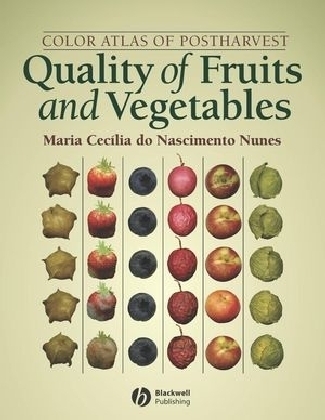
Color Atlas of Postharvest Quality of Fruits and Vegetables
Wiley-Blackwell (Verlag)
978-0-8138-1752-1 (ISBN)
- Titel z.Zt. nicht lieferbar
- Versandkostenfrei
- Auch auf Rechnung
- Artikel merken
The effects of time and temperature on the postharvest quality of fruits and vegetables are visually depicted in the Color Atlas of Postharvest Quality of Fruits and Vegetables. Through hundreds of vibrant color photographs, this unique resource illustrates how the appearance (e.g., color, shape, defects and injuries) of fruits and vegetables changes throughout their postharvest life and how storage temperature greatly contributes to critical quality changes.
The book’s extensive coverage describes 37 different fruits and vegetables from different groups that were stored at five specific temperatures and photographed daily after specified elapsed periods of time.
Individual fruits and vegetables from the following groups are covered:
subtropical and tropical fruits
pome and stone fruits
soft fruits and berries
cucurbitaceae
solanaceous and other fruit vegetables
legumes and brassicas
stem, leaf and other vegetable
and alliums
Information is provided about each individual fruit/vegetable such as characteristics, quality criteria and composition; recommendations for storage, transport and retail; and effects of temperature on the visual and compositional quality of each individual fruit or vegetable, associated with photos of the appearance at particular times and temperatures. This visual documentation shows how important is to handle fruits and vegetables at the right temperature and what happens if the recommendations are not followed. Also shown is the importance of the initial harvest quality of the fruit/vegetable and the expected shelf life as a function of quality at harvest, storage temperature and storage time.
The Color Atlas of Postharvest Quality of Fruits and Vegetables will appeal to a diverse group of food industry professionals in the areas of processing, distribution, retail, quality control, packaging, temperature control (refrigerated facilities or equipment) and marketing as a reference tool and to establish marketing priority criteria. Academic and scientific professionals in the area of postharvest physiology and technology, food science and nutrition can also use the book as a reference either for their study or in class to help students to visualize changes in the appearance of fruit/vegetables as a function of time/temperature.
Maria Cecilia do Nascimento Nunes, Ph.D., is Assistant Scientist in the Department of Food Science and Human Nutrition at the University of Florida, Gainesville, where she is also Courtesy Assistant Professor in the Department of Horticultural Sciences and a research member of the UF-IFAS Center for Food Distribution and Retailing.
Foreword. Acknowledgments.
Introduction.
Chapter 1. Subtropical and Tropical Fruits.
Grapefruit.
Orange.
Mandarin.
Mango.
Papaya.
Passion fruit.
Carambola.
Bibliography.
Chapter 2. Pome and Stone Fruits.
Apple.
Peach.
Bibliography.
Chapter 3. Soft Fruits and Berries.
Blackberry.
Blueberry.
Currant.
Raspberry.
Strawberry.
Bibliography.
Chapter 4. Cucurbitaceae.
Cantaloupe.
Watermelon.
Yellow Squash.
Bibliography.
Chapter 5. Solanaceous and Other Fruits Vegetables.
Tomato.
Cape Gooseberry.
Green Bell Pepper.
Eggplant.
Sweetcorn.
Bibliography.
Chapter 6. Legumes and Brassicas.
Faba Bean.
Snap Bean.
Cabbage.
Cauliflower.
Broccoli.
Brussels Sprouts.
Bibliography.
Chapter 7. Stem, Leaf and Other Vegetables.
Asparagus.
Lettuce.
Witloof Chicory.
Mushroom.
Bibliography.
Chapter 8. Alliums.
Leek.
Green Onion.
Fresh Garlic.
Bibliography
| Erscheint lt. Verlag | 6.6.2008 |
|---|---|
| Verlagsort | Hoboken |
| Sprache | englisch |
| Maße | 224 x 287 mm |
| Gewicht | 1733 g |
| Einbandart | gebunden |
| Themenwelt | Technik ► Lebensmitteltechnologie |
| Weitere Fachgebiete ► Land- / Forstwirtschaft / Fischerei | |
| ISBN-10 | 0-8138-1752-8 / 0813817528 |
| ISBN-13 | 978-0-8138-1752-1 / 9780813817521 |
| Zustand | Neuware |
| Haben Sie eine Frage zum Produkt? |
aus dem Bereich


